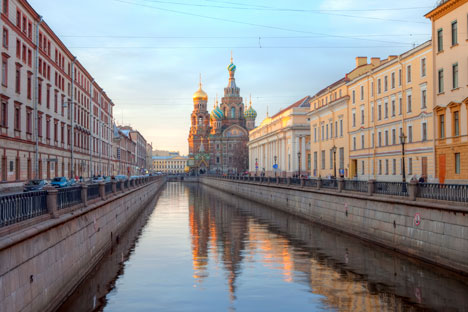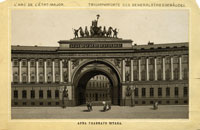The macabre history of Saint Petersburg

Cathedral of Our Savior on the Spilled Blood is the place of murder of Alexander II. Source: Lori/Legion Media.
St. Peterburg’s most notorious crime is the murder of Rasputin; an event that shaped the path of Russian history. Every day hundreds of tourists visit the Yusupov museum to see the famous rooms where the murder took place. But the macabre history of the Northern Capital began long before Grigory Rasputin was thrown into the Neva River. Indeed the draw of St. Petersburg lies as much in its stories of intrigue, ghosts and murder as in the architectural splendor of Nevsky Prospekt.
1. Mikhailovsky Castle. 1801. The murder of Paul I
One of the most ominous palaces in the center of St. Petersburg has to be Mikhailovsky Castle, also known as the Engineer’s Castle. Emperor Paul I, the son of Catherine the Great, built it for himself as an impenetrable sanctuary, but it was fated to become the place of his death. Subsequent modifications to the space in front of the castle make it hard to imagine just how serious the fortifications once were. During Paul’s reign, the castle was surrounded by a moat and an enclosed courtyard. Cannons stood watch on drawbridges.
But sadly for Paul, the moats, ramparts and guards were all to no avail as the castle guards were in on the plot to assassinate him. The chief guard, a man called Argamakov, led the conspirators straight to Paul’s bedroom. The conspirators claimed to have acted to protect the country from the whims of an insane emperor, and they were in fact a highly dignified group of people: among them were Governor-General of St. Petersburg Peter Pahlen, Vice-Chancellor Nikita Panin, Nikolai and Platon Zubov, commanders of four guard troops, and a number of officers. It is generally thought that the son of the victim, future emperor Alexander I, knew of the plot and approved it, either voluntary or under pressure. Alexander’s part in his father’s murder was something that haunted him for the rest of his life.
There is some debate over whether the conspirators wanted to kill the tsar or just remove him from power. According to historians, Paul hid himself, but the conspirators found him and tried to arrest him. A struggle ensued in which Nikolai Zubov struck Paul with a gold snuffbox. One version of the story claims Paul was immediately killed by this blow to the temple, but others say he was beaten to a pulp before being strangled with a silk scarf. It was announced that the tsar had died of a stroke. He had lived in Mikhailovsky Castle only 40 days. Paul reportedly had several visions of himself suffering strangulation that caused him to experience an unaccountable shortness of breath.
2. Cathedral of Our Savior on the Spilled Blood. 1881. Murder of Alexander II
The grand, elegant structure of the Church of the Savior on Spilt Blood - built in traditional Russian style in emulation of St. Basil’s Cathedral on Red Square – stands in sharp contrast to the sad event it was built to commemorate.
There were no obvious motives for the assassination of Emperor Alexander II. This tsar was neither a tyrant, like his father and his grandfather, nor a weak ruler, like his son and grandson. His official title as ‘the giver of freedom’ was well deserved – he was the ruler who finally abolished serfdom in Russia. But the assassins were grimly determined; first they tried to shoot him when he was out on a walk, then they attempted to blow him up in his own palace and again on a train.
On March 1, Alexander II was riding in his carriage on the way back to the Winter Palace when a bomb went off. The first explosion did nothing more than damage the carriage, but when the tsar got out to reprimand Nikolai Rusakov who had thrown the bomb, a second terrorist, Ignaty Grinevetsky, hurled another bomb at the tsar’s feet.
The exact place where the tsar was mortally wounded – part of the railings and the cobblestone pavement – has been preserved inside the cathedral, under the western cupola. For a long time the neighboring streets were named after the main participants in the plot - Sofia Perovskaya and Andrei Zhelyabov. They are now known as Malaya and Bolshaya Konyushennaya Streets.
3. Yusupov Palace. 1916. The murder of Rasputin
This Petersburg crime happened on Dec. 17, 1916 at the Yusupov residence on the Moika River. It actually started inside the historic palace in the lavish rooms of Prince Felix Yusupov. The conspirators acted to save the country and protect the tsar and his family from the influence of this mysterious peasant-monk.
The circumstances surrounding Rasputin’s death are well known: The monk was invited to the Yusupovs’ house on the pretext of meeting Felix’s wife. Here he was fed almond cakes laced with potassium cyanide. When this didn’t work, the plotters sprayed him with dozens of bullets, but the seemingly invincible Rasputin managed to run across the yard and climb over the fence. After this he was finally caught, seized and drowned in the icy Malaya Nevka River near Kamenny Island.
His embalmed corpse was secretly buried in the private Aleksandrovsky Park at Tsarkoe Selo, on the site of the Seraphim Sarovsky Cathedral, which was then under construction. Just one year later revolutionary soldiers found the grave and his body was destroyed, incinerated in the furnace of a boiler at the Polytechnic Institute. His ashes were scattered on the wind.
In 2005 an inscribed cross was placed at Rasputin’s first place of burial at Tsarskoe Selo.
The Yusupov Palace hosts a permanent exhibition entitled “Rasputin. Myth and Reality,” and in the painstakingly-restored reception rooms, it is possible to attend concerts and dances where, dressed in tails or a floor-length dress, guests can feel like real members of pre-revolutionary high society. Alternatively there are hourly tours of the palace every day from 11am that cover every stage of Rasputin’s murder.
{***}
4. Palace Square, General headquarters. 1918. Murder of Moisei Uritsky
On Aug. 30, 1918 in the vestibule of the Commissariat of Internal Affairs, which was located in the building of the General Headquarters on Palace Square, Moisei Uritsky, chairman of the Petersburg Emergency Committee, was shot by the young poet Leonid Kannegisser. The murderer managed to run away, but he didn’t get far – police caught up with him on neighboring Millionnaya Street. H was later executed. The consequences of the attack were frightening – after this murder, the Bolsheviks announced the start of the Red Terror.
Kannegisser said he was compelled to commit murder after his friend, the young officer Pereltsveiga, was shot while the prosecution tried to connect the assassination with the Socialist-Revolutionary Party, and to Fanny Kaplan’s assassination attempt on Vladimir Lenin in Moscow, which happened on the same day.
The murderer himself was an interesting character. Leonid Kannegisser came from a prosperous, well-educated Jewish family and he belonged to a social circle best described as bohemian, with all that implies. This suave and good-looking young man was well versed in politics, but he was also heavily influenced by the fashions of the time, and was a classic example of a revolutionary romantic. The murder was unlikely to have been planned – it all happened on the spur of the moment, motivated by a strange whim that is yet to be fully explained.
This event took place in a tunnel to left of the arch of the General Headquarters, in the semi-circular wing that leads towards Millionnaya Ulitsa. The vestibule window looks out onto the square where Kannegisser abandoned the bicycle he used to approach the scene of the crime.
5. Angleterre Hotel. 1925. The death of Sergei Esenin
In 1925, Russia’s premier poet, Sergei Esenin, was preparing for the release of a full collection of his works. “Nearly all poets in Russia die before they are able to see a full collection of their works. But I am going to see mine,” Esenin reportedly boasted. At the end of November the typeset for all three volumes of his works was in place. But then, on Dec. 28, 1925, Esenin was found dead in a room at the Angleterre Hotel. His final poem, “Goodbye, my friend, goodbye...” was written in blood – Esenin had actually complained that there was no ink in the hotel and he was forced to write in blood.
Most historians and biographers agree that Esenin, who was going through an episode of depression at the time, took his own life a month after being treated in a psychiatric hospital. At first no one questioned this version of events, but in the 1970s-1980s rumors began that the poet was in fact murdered and that the suicide was a cover-up: the perpetrator could have been motivated by money or jealousy or the murder could have been committed by the secret police.
All rights reserved by Rossiyskaya Gazeta.
Subscribe
to our newsletter!
Get the week's best stories straight to your inbox
